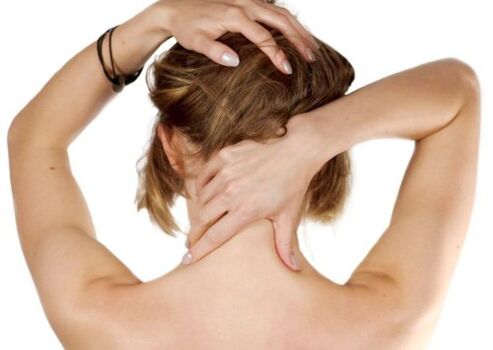According to medical observations, 50% of people over 25 suffer from mild osteochondrosis of the cervix. Such a clinical picture appears over the years and the percentage of patients increases every year. Signs of cervical osteochondrosis are attributed to fatigue and physical exertion, thus delaying treatment in the back of the burn. A progressive disease is a serious threat to the spine and the whole organism. Detect the first signs of osteochondrosis in time and do not delay to go to the doctor. He will prescribe you a course of treatment and perform a detailed examination.

What is osteochondrosis?
The importance of the topic of cervical osteochondrosis and its treatment is difficult to overestimate. Today, this is probably one of the major problems of society. The disease affects the intervertebral discs and bone tissue. According to statistics, osteochondrosis most often affects office workers, writers, programmers. The disease is dangerous for people with a fixed, sedentary lifestyle. Especially in the chest region. This is one of the inactive parts of the body, surrounded by ribs on all sides, which makes it difficult to diagnose.
Causes
Despite medical advances, no clear answer has been found to the question Why does osteochondrosis of the cervical spine occur? Based on data from a clinical practice study, there are several major causes of the disease:
- bad habits, smoking, alcohol, drugs;
- stationary lifestyle;
- intoxication of the body;
- loss from infection;
- daily hard physical work;
- stress, neurosis;
- spinal cord injury;
- wrong shoes - pressure on the spine;
- strong cooling of the body;
- lack of a healthy balanced diet;
- age-related changes;
- home medication;
- inheritance.
From the list above, it is clear that there can be many reasons. Therefore, complaints can be taken even in adolescence. Treatment of osteochondrosis at an early stage is effective, fast and painless.

The article reveals the basic concepts of cervical osteochondrosis, touches on a comparison with thoracic osteochondrosis. The signs that every person should know are described in detail and clearly.
Full picture of the disease
The signs of osteochondrosis of the cervical spine differ slightly from the signs of the disease in other vertebral regions. The main reason is the proximity of the intervertebral discs and their height. Common causes include pressure on the spinal cord and compression of nerve roots. This leads to the appearance of clinical symptoms, sometimes requiring immediate hospitalization.
The most popular signs
Pain syndrome
These are recurrent painful pains that have a different dislocation. They can be localized in one place and can affect the skeletal framework as a whole. When nerve roots are involved in the process, shooting in the extremities is characteristic. Frequent headaches are the cause of cervical muscle spasms of the occipital bone. As a result, there is a violation of blood circulation.
Nerve root damage
They stimulate muscle work and the nourishing effect on the skin of the hands. In this case, you can not lift heavy objects, physically overload and not delay treatment. As a result, you will get complete muscle atrophy.

Numbness of the fingers
Usually worries when the disease acquires a symptomatology and stable character. May be associated with discomfort in the hands and on the entire surface of the hands. In the advanced stage of osteochondrosis, numbness is a precursor to fainting and headaches. This sign indicates a significant decrease in sensitivity.
crunch
It limits our cervical spine movements and a person's physical abilities. The reduction of vertebral discs in height is a result of bone growth. The smaller nodes in the cervical vertebra are affected.
Loss of coordination and weakness in the body
These are signs due to lesions of the vertebral artery. It passes through its canal, which is located in the vertebrae of the cervix. The development of cervical osteochondrosis stimulates changes in the spine and the growth of fibrous tissue. The result is a lack of oxygen and impaired circulation. The head and occipital part of the cerebellum suffer.
Frequent dizziness
They are symptomatic and can be seen in osteochondrosis of the vertebral arteries. A large percentage of patients complain of excruciating migraine-like headaches. Patients try to get rid of painful symptoms by taking antibiotics and sedatives, which rarely make them feel better. This is a signal to the body for the rapid development and progression of osteochondrosis. Treatment in this case occurs immediately.

Blackheads or tremors fly in front of the eyes
Precursors of a severe headache. With sudden movements small colored spots appear and shots to the head. Many confuse this symptom with lack of sleep or fatigue, they take medication. As a rule, home medicine treatment in this case is always powerless.
Chest pain hurts
Some confuse them with heart pain because they are localized in the heart region. Others confuse it with a disease of other internal organs. Doctors urge you not to perform self-medication and methods of traditional medicine. This leads to severe consequences and difficulty in examination.
During the first visits to the attending physician, the patient is given a primary diagnosis, a spinal examination is performed, and the extent of its damage is determined. First of all, the doctor examines the human torso, structural features, the contours of the waist and neck, muscle relaxation, the level of elongation of the spinous processes. Basically, I examine and make a diagnosis with the help of my hands, but there are more modern modern methods:
- CT scan;
- Magnetic resonance imaging;
- radiography.
All methods are good, they have their disadvantages and advantages. With their help, you can finally approve or reject the diagnosis. Do not hesitate to consult a doctor. Effective treatment can only be achieved if medical recommendations are followed.



















